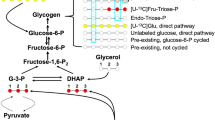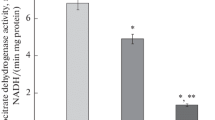Abstract
Most studies using a hypercaloric diet to induce obesity have focused on the metabolism of fat and carbohydrates. Less concern has been given to the metabolism of amino acids, despite evidence of modifications in nitrogen metabolism during obesity. The aim of this study was to evaluate amino acid metabolism in livers from cafeteria diet-induced obese rats. Blood parameters were analysed, and histological sections of livers were stained with Sudan III. The enzymatic activities of some enzymes were determined in liver homogenates. Gluconeogenesis, ureagenesis, and oxygen consumption were evaluated in rat livers perfused with glutamine, alanine, or ammonium chloride. Compared to control rats, cafeteria-fed rats demonstrated higher levels of triacylglycerol and glucose in the blood and greater accumulation of fat in livers. Gluconeogenesis and urea production in livers perfused with glutamine and alanine at higher concentrations showed a substantial reduction in cafeteria-fed rats. However, no significant difference was observed among groups perfused with ammonium chloride. The activities of the enzymes alanine aminotransferase, glutaminase, and aspartate aminotransferase in the livers were reduced in cafeteria-fed rats. Taken together, these data are consistent with the hypothesis that livers from cafeteria diet-induced obese rats exhibit a limitation in their maximal capacity to metabolise glutamine and alanine to glucose, ammonia, and urea, not because of an impairment in gluconeogenesis and/or ureagenesis, but rather due to a depression in the activities of enzymes that catalyse the initial steps of amino acid metabolism.





Similar content being viewed by others
References
Moore JB (2010) Conference on “over- and undernutrition: challenges and approaches” symposium 1: overnutrition: consequences and solutions non-alcoholic fatty liver disease: the hepatic consequence of obesity and the metabolic syndrome. Proc Nutr Soc 69:211–220. doi:10.1017/S0029665110000030
Yamamoto M, Yamamoto I, Tanaka Y, Ontko JA (1987) Fatty acid metabolism and lipid secretion by perfused livers from rats fed laboratory stock and sucrose-rich diets. J Lipid Res 28:1156–1165
Akiyama T, Tachibana I, Shirohara H, Watanabe N, Otsuki M (1996) High-fat hypercaloric diet induces obesity, glucose intolerance and hyperlipidemia in normal adult male Wistar rat. Diabetes Res Clin Pract 31:27–35. doi:10.1016/0168-8227(96)01205-3
Podolin DA, Wei Y, Pagliassotti MJ (1999) Effects of a high-fat diet and voluntary wheel running on gluconeogenesis and lipolysis in rats. J Appl Physiol 86:1374–1380
Estadella D, Oyama LM, Dâmaso AR, Ribeiro EB, Oller do Nascimento CM (2004) Effect of palatable hyperlipidic diet on lipid metabolism of sedentary and exercised rats. Nutrition 20:218–224. doi:10.1016/j.nut.2003.10.008
Chaves VE, Frasson D, Martins-Santos MES, Boschini RP, Garófalo MAR, Festuccia WTL, Kettelhut IC, Migliorini RH (2006) Glyceroneogenesis is reduced and glucose uptake is increased in adipose tissue from cafeteria diet-fed rats independently of tissue sympathetic innervation. J Nutr 136:2475–2480
Kohjima M, Enjoji M, Higuchi N, Kato M, Kotoh K, Yoshimoto T, Fujino T, Yada M, Yada R, Harada N, Takayanagi R, Nakamuta M (2007) Re-evaluation of fatty acid metabolism-related gene expression in nonalcoholic fatty liver disease. Int J Mol Med 20(3):351–358
Barber T, Viña JR, Viña J, Cabo J (1985) Decreased urea synthesis in cafeteria-diet-induced obesity in the rat. Biochem J 230:675–681
Esteve M, Rafecas I, Remesar X, Alemany M (1992) Nitrogen balances of lean and obese Zucker rats subjected to a cafeteria diet. Int J Obes Relat Metab Disord 16(4):237–244
Rafecas I, Esteve M, Fernández-López JA, Remesar X, Alemany M (1993) Individual amino acid balances in young lean and obese Zucker rats fed a cafeteria diet. Mol Cell Biochem 121:45–58. doi:10.1007/BF00928699
Segués T, Salvadó J, Arola L, Alemany M (1994) Long-term effects of cafeteria diet feeding on young Wistar rats. Biochem Mol Biol Int 33(2):321–328
Roig R, Esteve M, Remesar X, Lamers WH, Arola L, Salvadó J (1997) Regulation of ammonia-metabolizing enzymes expression in the liver of obese rats: differences between genetic and nutritional obesities. Int J Obes Metab Disord 21(8):681–685. doi:10.1038/sj.ijo.0800460
Elia M, Stubbs RJ, Henry CJ (1999) Differences in fat, carbohydrate, and protein metabolism between lean and obese subjects undergoing total starvation. Obes Res 7(6):597–604. doi:10.1002/j.1550-8528.1999.tb00720.x
Herrero MC, Remesar X, Arola L, Bladé C (1999) Ammonium uptake and urea production in hepatocytes from lean and obese Zucker rats. Mol Cell Biochem 200:163–167. doi:10.1023/A:1007003519678
Blouin A, Bolender RP, Weibel ER (1977) Distribution of organelles and membranes between hepatocytes and nonhepatocytes in the rat liver parenchyma. A stereological study. J Cell Biol 72:441–455. doi:10.1083/jcb.72.2.441
Yassuda Filho P, Bracht A, Ishii-Iwamoto EL, Lousano SH, Bracht L, Kelmer-Bracht AM (2003) The urea cycle in the liver of arthritic rats. Mol Cell Biochem 243:97–106. doi:10.1023/A:1021695625457
Corbello Pereira SR, Darronqui E, Constantin J, da Silva MHRA, Yamamoto NS, Bracht A (2004) The urea cycle and related pathways in the liver of Walker-256 tumor-bearing rats. Biochim Biophys Acta 1688:187–196. doi:10.1016/j.bbadis.2003.12.001
Sclafani A, Springer D (1976) Dietary obesity in adult rats: similarities to hypothalamic and human obesity syndromes. Physiol Behav 17(3):461–471. doi:10.1016/0031-9384(76)90109-8
MacQueen HA, Sadler DA, Moore SA, Daya S, Brown JY, Shuker DEG, Seaman M, Wassif WS (2007) Deleterious effects of a cafeteria diet on the livers of nonobese rats. Nutr Res 27:38–47. doi:10.1016/j.nutres.2006.10.003
Sampey BP, Vanhoose AM, Winfield HM, Freemerman AJ, Muehlbauer MJ, Fueger PT, Newgard CB, Makowski L (2011) Cafeteria diet is a robust model of human metabolic syndrome with liver and adipose inflammation: comparison to high-fat diet. Obesity 19:1109–1117. doi:10.1038/oby.2011.18
Opara EC, Petro A, Tevrizian A, Feinglos MN, Surwit RS (1996) l-Glutamine supplementation of a high fat diet reduces body weight and attenuates hyperglycemia and hyperinsulinemia in C57BL/6J mice. J Nutr 126(1):273–279
Ward E, Picton S, Reid U, Thomas D, Gardener C, Smith M, Henderson M, Holden V, Kinsey S, Lewis I, Allgar V (2003) Oral glutamine in paediatric oncology patients: a dose finding study. Eur J Clin Nutr 57:31–36. doi:10.1038/sj.ejcn.1601517
Greenfield JR, Farooqi IS, Keogh JM, Henning E, Habib AM, Blackwood A, Reimann F, Holst JJ, Gribble FM (2009) Oral glutamine increases circulating glucagon-like peptide 1, glucagon, and insulin concentrations in lean, obese, and type 2 diabetic subjects. Am J Clin Nutr 89:106–113. doi:10.3945/ajcn.2008.26362
Wu G (2010) Functional amino acids in growth, reproduction, and health. Adv Nutr 1(1):31–37. doi:10.3945/an.110.1008
Holecek M (2011) Adverse effects of chronic intake of glutamine-supplemented diet on amino acid concentrations and protein metabolism in rat: effect of short-term starvation. Eur e-J Clin Nutr Metab 6:e190–e196. doi:10.1016/j.eclnm.2011.05.002
Scoaris CR, Rizo GV, Roldi LP, de Moraes SMF, de Proença ARG, Peralta RM, Natali MRM (2010) Effects of cafeteria diet on the jejunum in sedentary and physically trained rats. Nutrition 26(3):312–320. doi:10.1016/j.nut.2009.04.012
Scholz R, Bücher T (1965) Hemoglobin-free perfusion of rat liver. In: Chance B, Estabrook RW, Williamson JR (eds) Control of energy metabolism. Academic Press, New York, pp 393–414
Kelmer-Bracht AM, Ishii EL, Andrade PVM, Bracht A (1984) Construction of a liver perfusion apparatus for studies on metabolic regulation and mechanisms of drug action. Arq Biol Tecnol 27:419–438
Bergmeyer HU (1974) Methods of enzymatic analysis. Verlag Chemie-Academic Press, Weinheim
Segal HL, Beattie DS, Hopper S (1962) Purification and properties of liver glutamic-alanine transaminase from normal and corticoid-treated rats. J Biol Chem 237(6):1914–1920
Lowry OH, Rosebrough NJ, Farr AL, Randall RJ (1951) Protein measurement with the folin phenol reagent. J Biol Chem 193:265–275
Salgueiro-Pagadigorria CL, Kelmer-Bracht AM, Bracht A, Ishii-Iwamoto EL (2005) Naproxen affects Ca2+ fluxes in mitochondria, microsomes and plasma membrane vesicles. Chem-Biol Interact 147:49–63. doi:10.1016/j.cbi.2003.10.004
Joseph SK, McGivan JD (1978) The effects of ammonium chloride and bicarbonate on the activity of glutaminase in isolated liver mitochondria. Biochem J 176(3):837–844
Du Ruisseau JP, Greenstein JP, Winitz M, Birnbaum SM (1957) Studies on the metabolism of amino acids and related compounds in vivo. VI. Free amino acid levels in the tissues of rats protected against ammonia toxicity. Arch Biochem Biophys 68:161–171
Yamamoto H, Aikawa T, Matsutaka H, lshikawa E (1974) Relative uptake of plasma amino acids by fetal and tumor tissues. Metabolism 23(11):1017–1022. doi:10.1016/0026-0495(74)90068-7
Häussinger D (1983) Hepatocyte heterogeneity in glutamine and ammonia metabolism and the role of an intercellular glutamine cycle during ureogenesis in perfused rat liver. Eur J Biochem 133:269–275. doi:10.1111/j.1432-1033.1983.tb07458.x
Botini FF, Suzuki-Kemmelmeier F, Nascimento EA, Ide LT, Bracht A (2005) Zonation of alanine metabolism in the bivascularly perfused rat liver. Liver Int 25:861–871. doi:10.1111/j.1478-3231.2005.01093.x
Comar JF, Suzuki-Kemmelmeier F, Constantin J, Bracht A (2010) Hepatic zonation of carbon and nitrogen fluxes derived from glutamine and ammonia transformations. J Biomed Sci 7:17–21. doi:10.1186/1423-0127-17-1
Wolford ST, Schroer RA, Gohs FX, Gallo PP, Brodeck M, Falk HB, Ruhren R (1986) Reference range data base for serum chemistry and hematology values in laboratory animals. J Toxicol Environ Health 18(2):161–188. doi:10.1080/15287398609530859
López IP, Marti A, Milagro FI, de Zulet M, Los A, Moreno-Aliaga MJ, Martinez JA, De Miguel C (2003) DNA microarray analysis of genes differentially expressed in diet-induced (cafeteria) obese rats. Obes Res 11(2):188–194. doi:10.1038/oby.2003.30
Lazarin M de O, Ishii-Iwamoto EL, Yamamoto NS, Constantin RP, Garcia RF, Costa CEM da, Vitoriano A de S, Oliveira MC de, Salgueiro-Pagadigorria CL (2011) Liver mitochondrial function and redox status in an experimental model of non-alcoholic fatty liver disease induced by monosodium L-glutamate in rats. Exp Mol Pathol 91:687–694. doi:10.1016/j.yexmp.2011.07.003
Herberg L, Major E, Hennigs U, Grüneklee D, Freytag G, Gries FA (1970) Differences in the development of the obese-hyperglycemic syndrome in obob and NZO mice. Diabetologia 6(3):292–299. doi:10.1007/BF01212241
Bielohuby M, Menhofer D, Kirchner H, Stoehr BJM, Müller TD, Stock P, Hempel M, Stemmer K, Pfluger PT, Kienzle E, Christ B, Tschöp MH, Bidlingmaier M (2011) Induction of ketosis in rats fed low-carbohydrate, high-fat diets depends on the relative abundance of dietary fat and protein. Am J Physiol Endocrinol Metab 300:E65–E76. doi:10.1152/ajpendo.00478.2010
Berry MN, Clark DG, Grivell AR, Wallace PG (1985) The contribution of hepatic metabolism to diet-induced thermogenesis. Metabolism 34(2):141–147. doi:10.1016/0026-0495(85)90123-4
Despres JP, Moorjani S, Lupien PJ, Tremblay A, Nadeau A, Bouchard C (1990) Regional distribution of body fat, plasma lipoproteins and cardiovascular disease. Arterioscler Thromb Vasc Biol 10(4):497–511. doi:10.1161/01.ATV.10.4.497
Heard CR, Frangi SM, Wright PM, McCartney PR (1977) Biochemical characteristics of different forms of protein-energy malnutrition: an experimental model using young rats. Br J Nutr 37(1):1–21. doi:10.1079/BJN19770003
Picó C, Pons A, Gianotti M, Palou A (1991) Sustained changes in blood alpha amino nitrogen compartmentation during recovery from cafeteria feeding in rats. Arch Int Physiol Biochim Biophys 99(4):345–348. doi:10.3109/13813459109146948
Noguchi Y, Shikata N, Furuhata Y, Kimura T, Takahashi M (2008) Characterization of dietary protein-dependent amino acid metabolism by linking free amino acids with transcriptional profiles through analysis of correlation. Physiol Genomics 34:315–326. doi:10.1152/physiolgenomics.00007.2008
Hoffman DJ, Seifert T, Borre A, Nellans HN (1995) Method to estimate the rate and extent of intestinal absorption in conscious rats using an absorption probe and portal blood sampling. Pharm Res 12(6):889–894. doi:10.1023/A:1016221322886
Saller R, Brignoli R, Melzer J, Meier R (2008) An updated systematic review with meta-analysis for the clinical evidence of silymarin. Forsch Komplementmed 15(1):9–20. doi:10.1159/000113648
Newsholme EA (1994) Biochemical control logic and the metabolism of glutamine. Nutrition 10(2):178–179
Malaisse WJ, Sener A, Carpinelli AR, Anjaneyulu K, Lebrun P, Herchuelz A, Christophe J (1980) The stimulus-secretion coupling of glucose-induced insulin release XLVI. Physiological role of l-glutamine as a fuel for pancreatic islets. Mol Cel Endocrinol 20(2):171–189. doi:10.1016/0303-7207(80)90080-5
Dechelotte P, Darmaun D, Rongier M, Hecketsweiler B, Rigal O, Desjeux JF (1991) Absorption and metabolic effects of enterally administered glutamine in humans. Am J Physiol Gastrointest Liver Physiol 260(5):G677–G682
Rennie MJ, Tadros L, Khogali S, Ahmed A, Taylor PM (1994) Glutamine transport and its metabolic effects. J Nutr 124(8S):1503S–1508S
Acknowledgments
This study was supported by grants from the Conselho Nacional de Desenvolvimento Científico (CNPq), Coordenação de Aperfeiçoamento de Pessoal de Nível Superior (CAPES) and the Fundação Araucária (FA). Cristiane Vizioli de Castro Ghizoni was supported by a scholarship from the CAPES.
Author information
Authors and Affiliations
Corresponding author
Rights and permissions
About this article
Cite this article
de Castro Ghizoni, C.V., Gasparin, F.R.S., Júnior, A.S.M. et al. Catabolism of amino acids in livers from cafeteria-fed rats. Mol Cell Biochem 373, 265–277 (2013). https://doi.org/10.1007/s11010-012-1499-0
Received:
Accepted:
Published:
Issue Date:
DOI: https://doi.org/10.1007/s11010-012-1499-0




